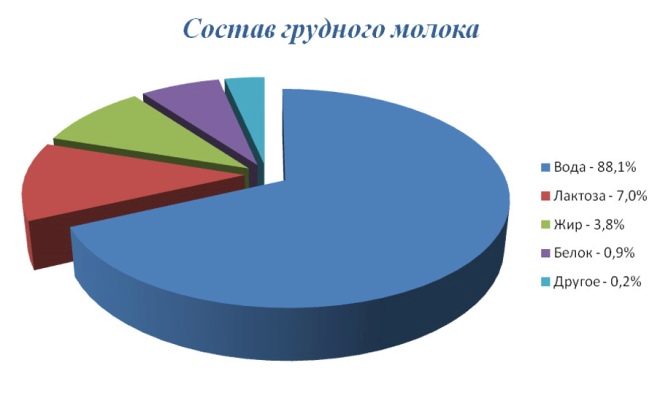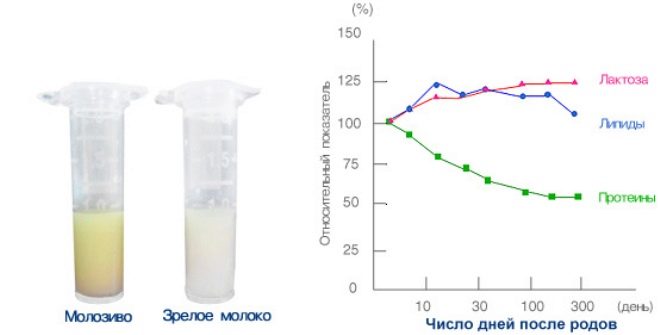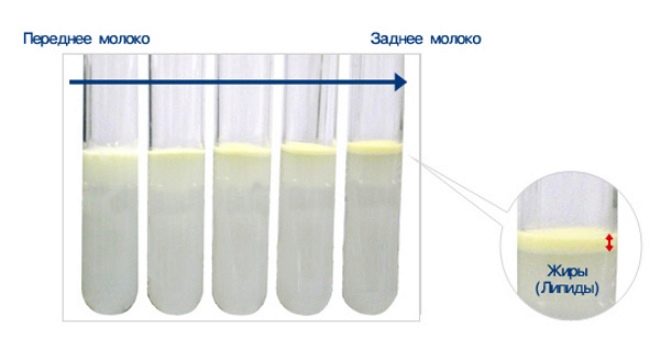The composition, fat content and temperature of breast milk
Breastmilk is the most suitable food for babies in the first six months after birth, because it contains all the nutrients that make the baby fully grow, stay healthy and develop. All of these substances are presented in it in the right just for your baby quantity and ratio.
Chemical composition and beneficial properties
Component | Percentage,% | Function in the children's body |
Squirrels | 1 |
|
Carbohydrates | 4 to 7 |
|
Fat | 2 to 4.5 |
|
Water | 87 |
|
Vitamins, minerals and other compounds | Less than 1 |
|
The average composition is presented in the following figure. About, what breast milk can look likeread in another article.
Squirrels represented mainly by easily digestible whey proteins. Hard-to-digest casein is found in much smaller amounts than cow's milk, which is the basis of most mixtures. Unlike cow's milk, there is more alpha-lactalbumin in women’s milk. The ratio of whey proteins to casein in a woman’s milk is 80 to 20. Among the amino acids there is taurine, which is important for stimulating the nervous system of the baby.
Fat in human milk are represented by easily digestible molecules, among which are many polyunsaturated acids (57%). These fatty acids play a significant role in the development of the child’s brain. The amount of fat often fluctuates. So, in colostrum it is only 2%, and in mature milk it is much more. For better digestion of fats, it also includes the enzyme lipase.
Carbohydrates represented predominantly by lactose. It not only affects the development of the nervous system, but is also necessary for microorganisms inhabiting the children's intestines. In addition, milk sugar is important for the absorption of calcium. In colostrum, lactose is less (only 4%), and in mature milk the amount of milk sugar rises to 7%.
Breast milk also contains special enzymesinvolved in the breakdown of nutrients that come with this valuable baby food.
Vitamins and minerals presented in dosages that are best absorbed by the body crumbs in a certain period of his life. Their number and ratio change, adapting to the needs of the infant.
In the colostrum, as well as in the "front" milk (the portion that the baby receives when feeding the first), there are more vitamins.
Breastmilk also contains a large number of active substances that cannot be contained even in the best formulas of the mixtures. These are different antibodies, hormones, lymphocytes, lysozyme, macrophages, epithelium cells, various growth factors and other compounds that are valuable for babies.
Fatness
This parameter is primarily interested in moms who are worried that the baby is not eating, naughty or gaining weight poorly.It is known that most of all fats are represented in the portion of milk that the baby receives at the end of feeding (it is called “back”). Accordingly, the "front" milk produced by the baby is less fat.
In fact, it is produced in the female breast of the same fat content, but as milk is produced, the fat molecules combine with each other and accumulate on the walls of the ducts, while the other components freely flow to the nipple.
The longer the break was after the last feeding, the less fatty milk the crumb would get at the beginning of its meal. Accordingly, the less time has elapsed since the previous feeding, the richer the “front” milk will be.
During feeding, the outflow of milk from the breast is accelerated and the molecules of fat, detaching from the walls, move along the ducts in the direction of the nipple. So the longer the mother feeds the baby, the more the baby will receive fat.
Temperature
Milk from a woman’s breast is the most optimal temperature for a baby. The temperature corresponds to the temperature of the woman’s body and does not depend on the season or other external conditions.
Special features
- The composition of milk in different women is very different. According to research, it is most suitable for the development of children of precisely these nursing mothers.
- In colostrum, the amount of proteins and minerals is increased, while mature milk contains much more carbohydrates and fats.
- The protein content in the milk of women is much less than in the milk of cows and other mammals.
- Iron is absorbed from it by 70% due to the presence of an auxiliary factor lactoferrin. From cow's milk, a child can absorb only 30% of iron, and from a mixture - only 10%.
- Women's milk is sterile, so it can be stored for some time at room temperature and not deteriorate.
- When digested in the stomach, it forms a loose clot, which quickly evacuates and is easily absorbed.



















